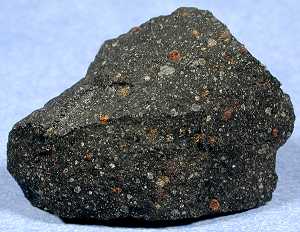
Chondrites
Chondrites are the most primitive
asteroids. They
are named for their primary constituent, chondrules, spherical grains that
directly condensed out of the solar nebula and which underwent one or more
heating and cooling cycles. Individual chondrules are thought to have formed in
distinctive locations within the solar nebula, but a chondrite typically
contains a mix of chondrites. Chondrites will also contain some
CAI's, and a
cement (matrix) formed from fine-grained dust. There are generally many inclusions
of assorted minerals, including nickel-iron grains, iron sulfides, magnetite,
and many other minerals, some unique to asteroids.
Especially interesting are inclusions called presolar grains, sometimes
called stardust. These are minerals thought to have formed in
supernovae or the outflows of other suns (such as red giants), and certainly
formed well before the other components of the chondrites. They pre-date the
solar system, hence the name. Presolar grains typically have distinctive
isotopic compositions reflecting their unique and alien birth. Presolar grains
include nanodiamonds, graphite, moissanite, titanium carbide, silicon nitride,
sapphire, spinel, olivine, and pyroxene, as well as a wide variety of other
minerals.
Chondrites are bodies which underwent little or no heating and differentiation,
but of course some are more pristine than others. The larger parent bodies would
have generated significant internal heat from the decay of relatively
short-lived isotopes, melting ice and allowing the formation of clays and other
hydrated minerals. Still larger bodies would have generated enough heat to have
(at least partially) melted, resulting in other asteroid types.
Chondrites include the following types:
- Ordinary Chondrites are common in the inner asteroid belt, and
comprise about 80% of all meteorites that fall to Earth, although they are
only 10%-15% of all asteroids.
- 40% of ordinary chondrites are H chondrites which have a
High-iron content
- 50% of them are L chondrites, with a low-iron content.
- 10% of them are LL chondrites, with a Low iron and overall
Low metal content.
- Carbonaceous Chondrites contain a significant percentage of
carbohydrates, and are typically dark. They are common in the outer Asteroid
Belt, representing about 75% of all asteroids. Their subgroubs are
usually identified by a "type meteorite" for which they are named. Each group is
thought to consist of meteorites sharing a common parent asteroid.
- CI group (Ivuna) may be the most pristine, with a chemical composition
nearly identical to the Sun, minus gasses including hydrogen and helium.
They contain up to 22% water, and show evidence of warming enough to
generate hydrated/hydroxide minerals such as phyllosilicates (including
clays). CI chondrites also contain significant organic matter including
Polycyclic Aromatic Hydrocarbons (PAH's) and amino acids.
- CM group (Mighei, although the best known sample is the Murchison
meteorite) chondrites contain perhaps 30% small chondrules and CAI's and 70%
matrix (dust). About 12% of the Murchison meteorite is water (in the form of
hydrous minerals).
- CO group (Omans) have about 70% small chondrules and CAI's in 30%
matrix, and show little aqueous processing.
- CR group (Renazzo) chondrites are about half matrix and half
chondrules with few CAI's, while being fairly rich in metallic nickel-iron.
They have generally experienced significant aqueous alteration.
- CH group (high metal) carbonaceous chondrites have very tiny
chondrules (averaging 20 microns), with clumps of dust instead of typical
matrix, and with a very small fraction of volatile elements. They are rich
in metallic nickel-iron compared to most carbonaceous chondrites.
- CB group (Bencubbin) carbonaceous chondrites have the highest
metal content and the lowest volatile element content.
- CV group (Vigarano) chondrites contain very abundant CAI's in a
roughly equal mix of millimeter-sized chondrites and matrix. The CAI's can
be quite large (centimeters). The best-known members of this group are the
Allende meteroites.
- CK group (Karoonda) chondrites are similar to CV's, but contain
far fewer CAI's, a higher degree of oxidation, and the greatest degree of
thermal metamorphism of all carbonaceous chondrites.
- E-type or Enstatite chondrites (named for their high
enstatite (MgSiO3) content) are extremely reduced; their iron is
elemental or sulfides. They comprise about 2% of meteorite falls on Earth.
The extremely reducing environment of formation for Enstatite chondrites
created a variety of unusual minerals, including oldhamite (CaS),
niningerite (MgS), and perryite (Fe-Ni silicide).
|